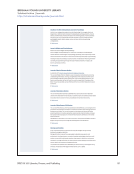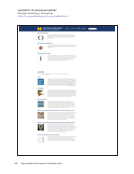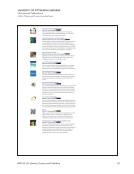10 Survey Results: Executive Summary
Libraries have addressed changing responsibilities for staff in a variety of ways. While 16
respondents (27%) report they have neither created new positions or redefined existing positions, 14
have created new positions, 14 have reconfigured existing positions, and 11 have done both to provide
publishing services. Three others plan to reconfigure positions and two plan to both create and redefine
positions. Explaining their reasons, respondents noted the desire to organize scholarly communications,
to provide a connector between press and library publishing along with digital scholarship, and to address
needs with publishing services growing from substantive institutional repository operations and needing
new positions to support demand.
Another question on which staff are involved in publishing activities asked about who heads
library publishing activities. The 51 positions described are diverse in terms of their title, department,
the position to which they report, and appointment type (librarian, other professional, support staff, or
other). This can be expected for a new and rapidly emerging area. Overall however, the positions share
commonalities. Many titles include the terms scholarly communications, digital scholarship, initiatives,
publishing, or repository. Many of these positions report to an associate dean or AUL, and typically are a
librarian or other professional.
Survey participants were also asked if the libraries had realized or identified opportunities for
enhanced workforce and/or workplace diversity and/or inclusivity (e.g., backgrounds, experiences,
races, ethnicities, gender identities, sexual orientation, and perspectives) when creating or reconfiguring
positions to provide publishing services. The majority of respondents had not (27, or 68%). Of those
responding affirmatively (13, or 33%), their comments noted involvement in the AAUP discussions
on diversity/inclusion for hiring practices, joint search committees with representatives from the
press and libraries to support an expanded framing for the necessary skills and experience, and a
diversity internship program with graduate students placed in the department. The prevalence of
graduate students could present an opportunity for recruiting new professionals into libraries and
library publishing.
Respondents commented that it was difficult to accurately answer the questions on how many
staff are engaged in publishing since staff are distributed across multiple units, there is limited dedicated
staffing, project-driven assignments are often temporary in nature, and staff for those are pulled from
existing units and areas to contribute efforts.
Sources of Funding for Publishing Activities
The survey also investigated whether there was a separate budget or distinct funding source for
publishing activities and the sources of funds to cover expenses. Four of the institutional presses have
a separate budget. In addition to those funds, they cover publishing expenses with grants, sales, and, in
three cases, library funds. Half of the library presses have a separate budget and/or some distinct funds.
All but one report that at least some expenses are covered by the greater library budget. They also rely
on cost recovery, sales, and grants to cover expenses. The majority of library publishing activities (50, or
91%) are covered by the general operating budget. A number of libraries also use endowment funds and
grants for publishing expenses.
Many respondents had the same difficulty reporting how much is spent each year on publishing
as they did counting the number of publishing-related staff. The main reason is because of the large
number of people involved and so many with only partial time allocations. Responses varied widely
on annual expenditures on publishing activities. Not surprisingly, salaries and benefits are the largest
expense. Estimates ranged from $6,000 to one million with a median of $100,000. Contract services are
the next largest expense ($1.5K to $150K+, median of $38,000), followed by materials (zero to $50K,
median of $8,000), and equipment (zero to $55K, median of $4,800).
Libraries have addressed changing responsibilities for staff in a variety of ways. While 16
respondents (27%) report they have neither created new positions or redefined existing positions, 14
have created new positions, 14 have reconfigured existing positions, and 11 have done both to provide
publishing services. Three others plan to reconfigure positions and two plan to both create and redefine
positions. Explaining their reasons, respondents noted the desire to organize scholarly communications,
to provide a connector between press and library publishing along with digital scholarship, and to address
needs with publishing services growing from substantive institutional repository operations and needing
new positions to support demand.
Another question on which staff are involved in publishing activities asked about who heads
library publishing activities. The 51 positions described are diverse in terms of their title, department,
the position to which they report, and appointment type (librarian, other professional, support staff, or
other). This can be expected for a new and rapidly emerging area. Overall however, the positions share
commonalities. Many titles include the terms scholarly communications, digital scholarship, initiatives,
publishing, or repository. Many of these positions report to an associate dean or AUL, and typically are a
librarian or other professional.
Survey participants were also asked if the libraries had realized or identified opportunities for
enhanced workforce and/or workplace diversity and/or inclusivity (e.g., backgrounds, experiences,
races, ethnicities, gender identities, sexual orientation, and perspectives) when creating or reconfiguring
positions to provide publishing services. The majority of respondents had not (27, or 68%). Of those
responding affirmatively (13, or 33%), their comments noted involvement in the AAUP discussions
on diversity/inclusion for hiring practices, joint search committees with representatives from the
press and libraries to support an expanded framing for the necessary skills and experience, and a
diversity internship program with graduate students placed in the department. The prevalence of
graduate students could present an opportunity for recruiting new professionals into libraries and
library publishing.
Respondents commented that it was difficult to accurately answer the questions on how many
staff are engaged in publishing since staff are distributed across multiple units, there is limited dedicated
staffing, project-driven assignments are often temporary in nature, and staff for those are pulled from
existing units and areas to contribute efforts.
Sources of Funding for Publishing Activities
The survey also investigated whether there was a separate budget or distinct funding source for
publishing activities and the sources of funds to cover expenses. Four of the institutional presses have
a separate budget. In addition to those funds, they cover publishing expenses with grants, sales, and, in
three cases, library funds. Half of the library presses have a separate budget and/or some distinct funds.
All but one report that at least some expenses are covered by the greater library budget. They also rely
on cost recovery, sales, and grants to cover expenses. The majority of library publishing activities (50, or
91%) are covered by the general operating budget. A number of libraries also use endowment funds and
grants for publishing expenses.
Many respondents had the same difficulty reporting how much is spent each year on publishing
as they did counting the number of publishing-related staff. The main reason is because of the large
number of people involved and so many with only partial time allocations. Responses varied widely
on annual expenditures on publishing activities. Not surprisingly, salaries and benefits are the largest
expense. Estimates ranged from $6,000 to one million with a median of $100,000. Contract services are
the next largest expense ($1.5K to $150K+, median of $38,000), followed by materials (zero to $50K,
median of $8,000), and equipment (zero to $55K, median of $4,800).



















































































































































































